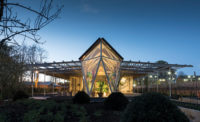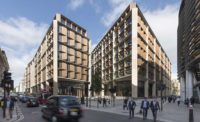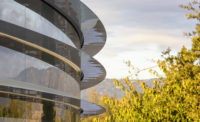Bloomberg’s new London headquarters, designed by Foster + Partners, reflects a concern for neighbors, both near and far. It is billed as the world’s most sustainable office building, and “in the twenty-first century, being a good neighbor means being a good steward of the environment,” says Mike Bloomberg. And as a “guest” in the city, being a good neighbor also means making an effort to “fit in,” he notes, which has informed the character of the 1.1 million-square-foot building.
Its 3.2-acre plot lies in the heart of the City of London financial district. Though it was possible to build up to 22 stories on part of the site, Bloomberg opted to conform to the ten-story height limit imposed elsewhere to protect views of St Paul’s Cathedral; in fact, the top two floors are set back so that only eight are visible.
Within the tight urban grain, where streets follow ancient patterns, “we were very conscious of the need to deliver some breathing space,” says project architect Michael Jones. The building is split into two, reinstating a public route through the site along the line of an old Roman road. Cutbacks at the corners form public plazas, edged by restaurants.
A deep sandstone frame lends a “classic” scale and order to the facades, while reflecting the materiality of nearby buildings. Bronze fins are inset within the frame, angled to give an impression of solidity when viewed obliquely and oriented to provide solar shading. For Norman Foster, the project represents “a new kind of balancing act between the use of weighty materials—of layering, depth and solidity—and the quality of lightness which has been a preoccupation of the office over decades”.
While the building’s exterior might be as sober as a well-cut City suit, “Mike Bloomberg was clear that the interior should reflect the dynamism of the company,” says Jones. Bloomberg also wished to avoid the grandiosity of typical office foyers, preferring a “gradual reveal, in which the building emerges as visitors move through it.” The double-height lobby comprises a ring of three curving, oak-clad shells, each leaning on the next. “We tried to reinterpret some quintessentially British details that you find around the City of London,” says Jones, “and this is literally a wood-paneled lobby with a twist.” Overhead, a work of art by Olafur Eliasson is one of many site-specific commissions in the building.
The so-called “Vortex” lobby disperses visitors to banks of elevators located against the facade. On the upper floors, the reason for perimeter cores becomes clear: in the heart of the building, where they would conventionally be found, a giant void allows clear views across floors and vertical circulation via elliptical ramps. “I’ve always been a believer in open offices,” says Bloomberg. “Walls get in the way of people coming together to solve problems”.
The serpentine coil of the ramps also provides a point of visual interest that is vital to a building with limited outward views, says Michael Jones. “You need something to visually and ‘spiritually’ elevate the place. Everyone focuses on one place in the interior, rather than looking out at different things—it’s a communal experience.”
The sky-lit void is a vital part of the natural ventilation system, funneling stale air to rooftop vents. Fresh air is admitted through the bronze facade fins, which contain attenuators to remove traffic noise. Norman Foster refers to these breathing wall elements as “gills,” and another organic metaphor is clearly suggested in the office ceilings, which comprise 2.5 million polished aluminium “petals.” Arranged like flower-heads, in tessellating clusters of six, they are folded to reflect light from integral LEDs and modify acoustics. Integrated cold water pipes allow the ceilings to chill incoming air in an energy-efficient way without creating condensation. Compressing all services into this four-inch-deep layer made it possible to fit ten stories within the building’s permitted envelope, each with floor-to-ceiling heights of at least 9.5 feet.
As in the exterior, materials used internally are predominantly natural and self-finished, and were chosen for their ability to age gracefully. Stone recurs on the walls, and a magnetic fixing system was developed to allow solid oak raised access floors. A 250-seat theater has leather seats and wool wall linings.
Technological ingenuity is expressed only subtly: to minimize visible lifting gear within glazed elevator enclosures, glass cars are cantilevered from the inside of the stone facade, and rise as if by magic. “The building is the tip of an iceberg,” says Foster. “What you don’t see is the enormous amount of teamwork and research that has gone into it.” Technical studies were extensive and, no doubt, expensive (no costs have been released). Ventilation calculations included the construction of a full-scale prototype of a piece of the building, large enough for 30 workstations, which was subjected to Arctic and tropical temperatures.
While a double-height social space dubbed - the 'Pantry' - serves coffee and snacks, the building otherwise offers few of the amenities with which peer companies try to keep staff on the premises. Instead, the 4,000 occupants are encouraged to venture outside for lunch or entertainment: helping local businesses is another part of being a good neighbor, says Michael Jones.
The public is also invited in, as visitors to a basement museum where the subterranean remains of the Roman Temple of Mithras will be presented alongside some of the 14,000 archaeological items recovered during construction. In restoring Roman heritage and responding to context, the Bloomberg building shows itself conscious of history while writing the next chapter. And in its material weight and crafted character, this well-behaved 'guest' gives a clear indication that it will be around for a long time to come.
















Post a comment to this article
Report Abusive Comment